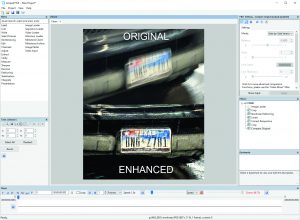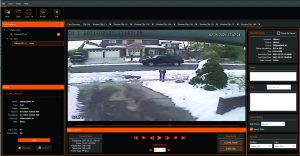According to one estimate, video evidence is now involved in roughly 80 percent of all criminal investigations.1 And that’s just one component of the modern digital landscape. Body-worn cameras, computers, smartphones, surveillance systems, and social media chatter are just a few of the most common sources of such evidence.
“We expect the amount and size of digital evidence to continue to grow,” said Peri Story, senior product marketing manager with OpenText, a globally recognized digital forensics leader headquartered in Waterloo, Ontario, Canada. “Not long ago, people would refer to gigabytes of information. Now we talk to people regularly who refer to terabytes of information for a single case. As this continues to grow, it’s going to outpace many traditional models.”2
The so-called internet of things is adding still more volume to the mix. Broadly defined as any physical object connected to the internet, one estimate puts the global number of these devices at 12.3 billion in 2021.3 This can include not only household devices but vehicles, drones, and even exercise equipment.
“The internet of things is becoming a bigger and bigger issue,” said Steve Watson, founder of VTO Labs in Broomfield, Colorado. “There are more of these kinds of devices connected to the internet now than there are computers and phones. But these are devices that many agencies don’t have the tools or the training to find out if there’s data on these devices, or how to access that data.”4
Regardless of the source, this veritable mountain of digital sources speaks to a core challenge for agencies looking to leverage digital forensics in their day-to-day work. While these devices can provide a veritable treasure trove of information, the data on them can be time-consuming to sift through, and often require specialized expertise to access.
As devices and their data continue to factor more heavily into daily life, law enforcement is also using technologies—in the physical as well as digital world—to optimize every investigation. A raft of vendors and providers can help them fill the gaps and expedite the process with products and services designed specifically to help police get the most out of every file and device.
Actionable and Accessible
Mining data, converting it to evidence, and maintaining the chain of custody are all top of mind for today’s providers of digital forensics solutions.
With this in mind, OpenText offers solutions that shepherd evidence through the entire process, from collection to submission to transfer to disposal. This, company officials say, enables authorized personnel to manage evidence more easily—and without needing to alter the original evidence.
“Because of the volume of digital evidence, the ability to quickly identify things that you’re looking for is becoming more and more important for the investigator or examiner,” said Chuck Dodson, senior director of strategic programs for OpenText. “The idea is to streamline or automate the workload so that you get better investigations, faster case closures, and more comprehensive prosecutions.”5
Sometimes there can be physical roadblocks, particularly when a device has been damaged. Repairing these devices enough so that their data can be accessed can be a tricky and intricate endeavor. That’s when where VTO Labs come into the picture.
“They may have been through fires, they have been exploded, run over by a vehicle, or kept underwater for some length of time,” Watson said. “When we get those devices, we clean them, stabilize them, and retrieve their data.”
Audio/Visual
Although plenty of other sources are becoming more prevalent and will continue to do so, video remains the dominant source of data in the digital forensics world.

Amped FIVE, developed by Italy-based Amped Software, is a digital video and image enhancement service currently used by law enforcement agencies and courtrooms in more than 100 countries. The service allows users to access images and videos from hundreds of proprietary formats, analyze and interpret file data and structure, restore and enhance images to clarify objects such as license plates and faces, and easily create video presentations and reports.
“One of the issues we have seen is the growing need to accurately look at image and video evidence,” said Blake Sawyer, Amped Software’s head of technical sales and support. “The average person is captured on camera 230 times per week. Having tools that make sure the files you work with are handled properly and users understand what is happening is becoming crucial.”6
One of the most common sources of video are surveillance systems. The key challenge is that surveillance systems—or, more specifically, the digital video recorders (DVR) that actually store the video and image files—can be complex and heterogeneous. Special training is typically needed in order for law enforcement to properly access the footage.
DVR Examiner, created by DME Forensics, which is now a part of Magnet Forensics, a well-known Ontario firm, is a tool designed for this exact function. The end result is more usable video recovered and lots of time saved.

“DVR Examiner helps police agencies by automating video evidence recovery from a wide variety of DVR surveillance systems in a forensically sound manner,” said Jimmy Schroering, founder of DME Forensics and director of video forensics technology with Magnet Forensics. “Previously, this work had to be done manually and was both time-consuming and technically difficult given the wide variety and complexity of DVR systems available. Technical personnel with training and certification can be difficult for police agencies to attract and retain. Digital video evidence recovery and analysis work can create lengthy backlogs and delay investigations and judicial proceedings. DVR Examiner can quickly and safely recover video in just a few clicks.”7
Surveillance, of course, doesn’t end with video. Audio recordings also are critically important to many investigations. Tools from Phonexia, a company based in the Czech Republic, are specially designed to help not only identify but contextualize voices and other recordings.
The Phonexia Orbis Investigator automatically identifies speakers and other key metadata in audio recordings and then visualizes relations among them. Additionally, the Phonexia Voice Inspector is highly accurate speaker recognition software to support effective criminal investigations.
“Phonexia automates the tiresome and inefficient routine of listening to every single audio recording of legally intercepted conversations,” said Miroslav Jirku, Phonexia’s vice president of marketing. “Through automated analysis of recordings and instant focus on key findings, investigators can be significantly more efficient and resolve cases faster. The greater the number of audio recordings you work with, the greater the time that can be saved with Phonexia products.”8
In the Field
Digital forensics is useful well beyond the digital world. In the physical world, AXO Science, which is headquartered in France, developed STK Sperm Tracker, a digital screening tool for identifying semen at a rape scene or on a victim’s body.
“In order to fight crime efficiently, CSI and forensic experts require technologies for a rapid, nondestructive, and accurate detection of a wide variety of evidences, including invisible bodily fluids stains,” said Samuel Serraz, AXO’s vice president of sales and marketing. “In the event of rape, being able to locate and then analyze semen is absolutely crucial as those traces have high odds of containing aggressor DNA.”9
More effective than widespread alternatives like spot tests or special light sources, STK Lab, STK Spray, and STK Skin are all specific to human semen and highly sensitive. Moreover, STK solutions are easy to use, nontoxic, and safe for DNA.
“It is estimated that one woman out of five will face rape or attempted rape during her lifetime,” Serraz said. “The trend in rape increased in the last decade and is accelerating since 2017. Ninety-nine percent of rapes are committed by a male. Locating semen is thus important in essentially every rape case.”
No matter the situation, it’s clear that digital devices—and the evidence they create—will only continue to mount in coming years. Fortunately, the resources available to law enforcement today are keeping pace and are already helping agencies around the world close more cases more quickly.d
Notes:
1 Global Justice Information Sharing Initiative, Video Evidence: A Primer for Prosecutors (U.S. Bureau of Justice Assistance, 2016).
2 Peri Story (senior product marketing manager, OpenText), phone interview, January 5, 2022.
3 Satyajit Sinha, “State of IoT 2021: Number of Connected IoT Devices Growing 9% to 12.3 Billion Globally, Cellular IoT Now Surpassing 2 Billion,” IOT Analytics, September 22, 2021.
4 Steve Watson (founder, VTO Labs), phone interview, December 15, 2021.
5 Chuck Dodson (senior director of strategic programs, OpenText), phone interview, January 5, 2022.
6 Blake Sawyer (head of technical sales and support, Amped Software), email interview, December 21, 2021.
7 Jimmy Schroering (founder, DME Forensics), email interview, December 21, 2021.
8 Miroslav Jirku (vice president of marketing, Phonexia), email interview, December 17, 2021.
9 Samuel Serraz (vice president of sales and marketing, AXO), email interview, December 20, 2021.
|
SOURCE LIST Please click on the companies’ names to go to their websites or visit the Police Chief Buyers’ Guide to request information from companies. |
||
|
DME Forensics | Magnet Forensics
|
|
|


